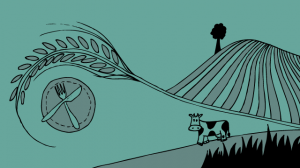
Artwork by Iona Richards
In organic farming, artificial chemical fertilizers are not used, pesticide use is restricted and only non-genetically modified crops and animals are reared. For animals, the routine use of antibiotics and other drugs is prohibited and animal welfare is at the heart of the system. Furthermore, crops and animals are rotated over the seasons, allowing for new ones to be brought in and therefore breaking pest and disease cycles. Fields are allowed to lay fallow and soil fertility is achieved through natural means such as growing legumes. This is farming stripped back to its roots.
Yet organic farming often has the public perplexed. Is it more healthy? Is it better for the environment? And with a growing population, can we really afford to relinquish modern inventions such as fertilizers, pesticides and high-yielding GM crops?
The prohibition of genetically modified organisms is a controversial issue. The bottom line is that genetically modified food is not bad for you. But it may have ecological, economic and ethical consequences that are difficult to measure and control. The introduction of pest resistance genes into crops causes ecological problems when these strains out-compete wild types, or when they become so prevalent in the environment that the balance of the evolutionary arms race tilts, and pests evolve a counter-attack more rapidly than anticipated. Sometimes, however, the non-GM alternatives are simply not adequate to meet demands. It is arguably better, both economically and environmentally, to create a prolific and pest-resistant strain of maize than to constantly shower it in pesticides. But this does reduce diversity in the crop’s gene pool and encourage monoculture, a form of farming where the land is dominated by one crop species, year after year, and which can lead to the rapid spread of disease – something which organic farming combats.
Fertilizers have increased global crop yields by 30-50%. The Haber-Bosch process is one of the most important chemical reactions in the agricultural world and it enables us to create synthetic fertilizers to increase the nitrogen content of soil – a critical limiting factor determining plant growth and quality. It is estimated that this process sustains one third of the world’s population as it allows agriculture on soils that are not naturally fertile. But the process is energetically costly, as the required high pressures and temperatures (around 300-500 degrees Celsius) are difficult to maintain. Other problems with chemical fertilizers include water pollution and eutrophication (overgrowth of algae on ponds and still water), crop contamination, soil acidification and destruction of soil microfauna, including fungi called mycorrhizae, which aid the plant in taking up soil nutrients and can also defend the plant from toxic chemicals and disease. In addition, the process of fertilization itself is unsustainable, because fossil fuels are required to meet the high energy demands of fertilizer production.
An alternative is organic fertilizer – which has its benefits. Firstly, it is made using naturally occurring waste products, such as manure, bones and worm castings. Secondly, it has been shown to improve soil biodiversity and long-term soil productivity over soils treated with chemical fertilizers. It encourages root symbiosis with mycorrhizae which naturally increases crop yield. But organic fertilizers are variable in nutrient content, whilst the nutrient ratios in artificial fertilizers can be tailored exactly to suit different soil and crop types. Furthermore, the nutrients in artificial fertilizers are released at a steady constant rate and almost all of the nutrient content is readily available for the plants, in contrast to organic fertilizers where only 25-60% is bioavailable (i.e. not chemically bonded to another element) and the rate of release is inconsistent. Overall, organic fertilizers have a much slower rate of release which may not be ideal when there is a demand for fast growing crops. We must also remember that organic fertilizers do not totally eradicate the problems of acidification and eutrophication.
Where organic farming really shines is in its treatment of livestock. Organic farming stipulates that all animals have an entirely free-range rearing, with the welfare of the animal a primary concern. Antibiotics are not used without necessity which reduces the selective pressure on pathogens to evolve antibiotic-resistant strains. There is a huge demand in the market for high quality meat. This drives the business of factory farming where the welfare of animals is of low priority. Although one might argue the economic cost of free-range farming is that it requires more land which could be more efficiently used to grow crops, the ethical and environmental costs of factory farming are arguably greater.
Our large and booming population will not allow for a worldwide conversion to organic practices, although there is a lot to be learned from them. They encourage the preservation of wild types and different species, thus increasing genetic diversity, an important factor for crop resilience against disease. Our reliance on the unsustainable production of chemical fertilizers needs to be curtailed in favour of organic alternatives. Perhaps in the countries that can afford it, both financially and environmentally, there should be a drive towards an organic, sustainable practice of agriculture. Ultimately though, the achievement of sustainable agriculture can only be reached in tandem with management of population growth and tapping into new and sustainable energy sources.
![Organic farming: how taking a step back in time can be the best way forward In organic farming, artificial chemical fertilizers are not used, pesticide use is restricted and only non-genetically modified crops and animals are reared. For animals, the […]](/wp-content/uploads/2013/11/ethical-eating-620x300.png)